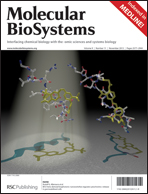A semi-quantitative model of Quorum-Sensing in Staphylococcus aureus, approved by microarray meta-analyses and tested by mutation studies†
Abstract
Staphylococcus aureus (SA) causes infections including severe sepsis by antibiotic-resistant strains. It forms biofilms to protect itself from the host and antibiotics. Biofilm and planktonic lifestyle are regulated by a complex quorum sensing system (QS) with the central regulator agr. To study biofilm formation and QS we set up a Boolean node interaction network (94 nodes, 184 edges) that included different two component systems such as agr, sae and arl. Proteins such as sar, rot and sigB were included. Each gene node represents the resulting activity of its gene products (mRNA and protein). Network consistency was tested according to previous knowledge and the literature. Regulator mutation combinations (agr−, sae−, sae−/agr−, sigB+, sigB+/sae−) were tested in silico in the model and compared regarding system changes and responses to experimental gene expression data. High connectivity served as a guide to identify master regulators, and their detailed behaviour was studied both in vitro and in the model. System analysis showed two stable states, biofilm forming versus planktonic, with clearly different sub-networks turned on. Predicted node activity changes from the in silico model were in line with microarray gene expression data of different knockout strains. Additional in silico predictions about node activity and biofilm formation were compared to new in vitro experiments (northern blots and biofilm adherence assays) which confirmed these. Further experiments in silico as well as in vitro showed the sae locus as the central modulator of biofilm production. Sae knockout strains showed stronger biofilms. Wild type phenotype was rescued by sae complementation. The in silico network provides a theoretical model that agrees well with the presented experimental data on how integration of different inputs is achieved in the QS of SA. It faithfully reproduces the behaviour of QS mutants and their biofilm forming ability and allows predictions about mutations and mutation combinations for any node in the network. The model and simulations allow us to study QS and biofilm formation in SA including behaviour of MRSA strains and mutants. The in vitro and in silico evidence stresses the role of sae and agr in fine-tuning biofilm repression and/or SA dissemination.


 Please wait while we load your content...
Please wait while we load your content...